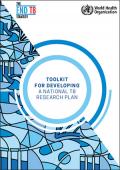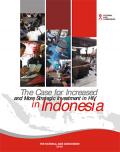What's New
Displaying results 2761 - 2770 of 4914

Resource | Publications,
When the world first set out to eradicate smallpox nearly 50 years ago, many felt it was not possible, and some were even strongly against the idea. Visionaries in the early global AIDS response were also met with resistance when they suggested that AIDS medicines could be provided to all who needed them regardless of their income or status in society. As with those who doubted the eradication of small pox was possible, they were proven wrong.
What shifted and made these successes possible? It was the belief that change was not only possible, but necessary.
These are the questions that The Global Plan to End TB 2016-2020: The Paradigm Shift seeks to answer. It is an ambitious plan of action that provides a blueprint for the TB community to drive bold action and ambitious change. A Task Force of world renowned experts and a wide community of dedicated people working on TB came together to contribute to the development of this plan.

Resource | Infographics,
World leaders are meeting in Addis Ababa, Ethiopia for the UN Financing for Development Conference to discuss financing for the Sustainable Development Goals (SDGs), a new set of global development targets. The draft SDG goals include a target to end the epidemic of tuberculosis by 2030, in line with the
WHO End TB Strategy and the Global Plan to Stop TB 2016-2020.
In order to achieve these targets, increased investments for tuberculosis (TB) will be essential to set the world on course to end TB in our lifetime. However, many countries are failing to step up with the needed investments.

Resource | Publications,
The Essentials provides in-depth explanations of the vision, goal, targets and milestones of the End TB Strategy as well as the key indicators to measure progress. It then outlines the essential features of operationalizing the principles, pillars and components of the End TB Strategy. Country experiences are included throughout as examples in applying elements of the strategy.
The Essentials is organized in three parts: Part I presents the overall approach, principles and the first steps of implementation expected at the country level. Part II explains the vision, goal, indicators, targets and milestones of the Strategy and Part III outlines the policies, the actors and actions needed to help implement the new approaches laid out under the three pillars of the Strategy: (i) Integrated, patient-centred care and prevention; (ii) Bold policies and supportive systems; and (iii) Intensified research and innovation.

Resource | Publications,
Tuberculosis (TB) kills more women globally than any other single infectious disease, and more women die annually of TB than of all causes of maternal mortality combined. Women who are co-infected with TB and HIV are significantly more likely to die of TB than co-infected men. Globally, more men have TB than women.
This discussion paper on gender and TB is intended to support practitioners, civil society and government partners wishing to make the investment case for increased and improved TB programming that addresses the specific vulnerabilities and needs of both men and women who are living with or at risk of TB. The paper summarizes the existing evidence base, demonstrating the ways in which gender has an impact on the risks and effects of TB (including those that intersect with HIV), and highlighting existing gaps in data and implementation. This information is useful for UNDP in its role in supporting governments to implement and operationalize the development agenda by 2030, by turning commitments into action.

Resource | Publications,
The 2013-2016 Laboratory Network Strategic Plan (LNSP) is a sub-plan of the 2010-2016 Philippine Plan of Action to Control Tuberculosis (PhilPACT). This plan will serve as a roadmap to strengthen the network’s laboratory services to control TB. It is aligned with various existing strategic plans to improve the laboratory facilities and activities in the country.
The development of the LNSP took a significant amount of time, various multistakeholder consultations and technical expertise from DOH, NTP and partner technical agencies. The Technical Working Group (TWG) of the LNSP ensured alignment of the plan to various important documents of different agencies of the government, administrative and department orders, memoranda and office orders.
The Strength-Weakness-Opportunity-Threat (SWOT) analysis serves as the backbone for the prioritization of the key gaps to be addressed by the LNSP. Since the laboratory network is a complex system and various challenges need to be addressed in the next four years, there are four key gaps that will be addressed as priority, namely: (1) limited access to TB diagnostic services, (2) insufficient laboratory network management systems, (3) inadequate funding for the laboratory network and (4) weak leadership and management of the laboratory network.

Resource | Publications,
India has a high burden of both tuberculosis (TB) and HIV, and faces a high burden of HIV-associated TB. While TB is endemic, the HIV epidemic is concentrated in a few states. A national response to TB epidemic was initially integrated in the general health system through the revised national TB control programme. This differed from the staggered response to the HIV epidemic under the national AIDS control programme, where programmes were initiated in high HIV burden states and gradually expanded to the rest of the country. Over the past decade, the HIV epidemic in India has expanded to historically low prevalence settings. However, this increase was not met by increased local programme capacities, and this situation created hurdles for rapid scale-up of collaborative TB/HIV activities and gaps in the detection and treatment of HIV and HIV-associated TB. Facilitated by the joint national TB/HIV policy, national TB and HIV programmes have systematically addressed these gaps and succeeded in reducing the incidence, prevalence and mortality due to TB, HIV and HIV-associated TB.
This case study documents the experience of the scale-up of collaborative TB/HIV activities in India over the past decade, exploring the challenges encountered and the steps taken by national TB and HIV programmes collectively to address them. The key lesson learned from this experience is that collaborative TB/HIV activities can be scaled up successfully in concentrated HIV epidemic settings if TB and HIV programmes share ownership of TB/HIV interventions.

Resource | Publications,
Tuberculosis (TB) remains an important global health problem. Although a number of important advances have been made to control TB in the past decade, an estimated 10.4 million people fell ill with TB and 1.8 million died from the disease in 2015. WHO’s Global TB Programme has identified research and innovation as one of the three essential pillars to end TB as a public health threat by 2030. This document provides the structure and tools that enable the necessary actions to be taken to address country-specific TB challenges and ensure that national response activities are supported by evidence to the fullest extent possible.
This document describes how to develop a country-specific approach to utilizing research and innovation to strengthen and improve TB care and control. It provides a series of tools for developing and implementing a national TB research plan that will help in leveraging individual country action to address the global TB burden. These tools will assist a country’s national TB control programme or its equivalent to develop an effective national TB research plan through a coherent step-by-step process.

Baseline Characteristics of Patients Attending the SHC in the First 3 1⁄2 Months of Clinic Operation
Resource | Presentations,
This presentation summarizes the report which aims to study the baseline characteristics of enrolled patients in the first 3 1/2 months of SHC operation.

Resource | Publications,
This analysis was done to estimate the required investments in the future to respond to HIV and AIDS in a cost-effective and optimal manner.
The result of the Investment Case Analysis (ICA) has been reviewed by all stakeholders involved in the national technical team which comprised the Ministry of Health, the National AIDS Commission, and development partners like DFAT, WHO and UNAIDS. The results of this review are based on an analysis of the best and most current data available as of September 2014 in terms of HIV epidemic data, the 2013 IBBS for category B districts, the 2013 Papua IBBS, and revised 2014 unit cost for treatment. Analysis obtained from the study results has also guided the selection of the optimal scenario for the National HIV and AIDS Strategy and Action Plan 2015-2019 and informed the preparation of Indonesia’s Global Fund New Funding Model Concept note in 2015.

Resource | Publications,
This report examines the socio-economic situation of households, including size, age, health, education, and economic condition, left behind by migrants. As presented in the report, when an older parent is left-behind they could be living with grandchild, spouse, child (sibling of the migrant) or other person. Almost 20% of households with an elderly parent left-behind also contain a child of the migrant (their grandchild). The report shows a higher probability of living in poor socio-economic conditions when a child of a migrant under age 12 is left behind in other situations. Socio-economic conditions tend to be worse in left behind households,that contain a single parent of the migrant (usually female) than in other households. Migrant households with younger children may be doing worse because adults living with children in poor socioeconomic conditions have greater impetus to migrate in an attempt to find better work than is available in their community of origin.





